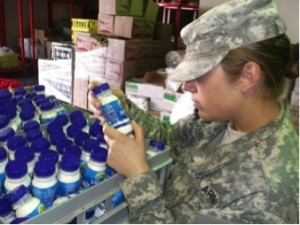
DOHA, Qatar – There are multiple layers of food safety in the rations available to soldiers and civilians at Camp As Sayliyah in Qatar. Veterinary Services, Preventive Medicine and Dining Facility sections all play parts in the production of safe, wholesome food for your consumption.
Area Support Group-Qatar serves as an U.S. Army component headquarters for assigned army force and joint tenant units at Camp As Sayliyah and other designated locations in Qatar and the U.S. Central Command area of responsibility.
The first layer of protection is provided by officers of the Veterinary Corps. These officers perform commercial sanitary audits of facilities that produce food and water or store products that the military will purchase at a wholesale level. These audits focus on safety of the product and sanitation of the plant with the goal of eliminating food poisoning occurring to our service members.
The second layer of protection also involves the Veterinary Corps. The enlisted soldiers and noncommissioned officer’s of the food inspection branch perform receipt inspections of products that arrive on U.S. Army installations, whether it is food available at the local Army and Air Force Exchange Servicep stores, the Dining Facility or Chili’s, the food inspectors check the products to ensure containers have not been tampered with, the produce is wholesome and not infested with insects or rodents, and verify that the products in the shipment come from approved sources; facilities that have had commercial sanitary audits.
Any shipments that are not up to standard are refused and returned to the vendor and an action plan is developed to avoid the issue from occurring in the future. The food inspectors also perform extensions of products that have expired, if the product passes safety testing. If the expired product is not wholesome or safe, it is condemned and the accountable officers must dispose of it. If the product passes safety testing and is still wholesome and safe, it is given an extension and pushed for immediate consumption. Food inspectors also respond to food and drug recalls and ensure that if the affected product is in their area of operation they segregate it, turn in samples for laboratory testing and place the remaining product on medical hold until further instructions are given.
The third layer of protection involves the soldiers of preventive medicine units. Their focus is often at the preparation level for the food. They check to make sure that temperatures are correct, hot food stays hot and cold food stays cold, and the temperature danger zone is avoided. Temperatures between 40F and 140F allow bacteria to multiply rapidly. Food that is not kept above or below these temperatures has a greater chance of causing food poisoning.
Preventive medicine is often involved in testing water sources for chemicals, bacteria and other contaminants. They run a variety of tests to ensure that the water that is available to soldiers is safe or potable. If you see water that is labeled as non-potable, it is not safe for drinking. Preventive medicine is often involved in ensuring that proper hand washing facilities are present at dining facilities. Suspicious illnesses and suspected food borne illnesses are also investigated by Preventive Medicine epidemiologists.
The fourth layer of food safety is accomplished by the dining facility staff or mess sections. They are responsible for cooking the food properly and maintaining it at a safe temperature as well as storing it properly. They are in charge of practicing the FIFO principle, first in and first out, which may be more familiarly known as rotating stock, using the oldest products first. The mess section is responsible for the cooks and line staff hygiene, as well as the cleaning and sanitation of the facility, utensils, and equipment. There are annual reviews of menus served by dining facilities to ensure that complete, balanced and nutritious meals are available to service members.
There are several other factors that can contribute to food safety. Food and Water Risk Assessments are performed by veterinary personnel, upon request, for locations that will serve food to service members on an infrequent basis, perhaps just once.
The assessment is meant to give the local commander the information needed to determine if the risk is acceptable. If a unit wants to have a special meal catered by an agency that has not been audited, they can request an FWRA. A veterinary officer will inspect the facility for potential health hazards and give advice on methods to reduce the hazards and the overall level of risk presented by the food.
When deployed overseas there is some level of risk involved in eating on the economy and you can find out more information about low and high risk foods from the Public Health Command website.
Read more: http://www.dvidshub.net/news/111313/protecting-force-food-safety#.Uf6UCoWfuJQ#ixzz2b1XqzPHn






